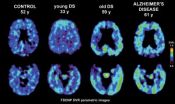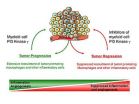(Press-News.org) A paper published online on June 13 in the Journal of Experimental Medicine (www.jem.org) identifies new gene mutations in patients with chronic lymphocytic leukemia (CLL)—a disease often associated with lack of response to chemotherapy and poor overall survival.
CLL is the most common leukemia in the Western world, but the disease varies greatly from patient to patient with regard to prognosis, survival, and disease course. In attempt to understand the genetic basis for this heterogeneity, a group led by Riccardo Dalla-Favera at Columbia University and Gianluca Gaidano at Amedeo Avogadro University of Eastern Piedmont, Novara, Italy surveyed the landscape of mutations in the genes of CLL patients. They found several mutations not previously linked with CLL, but most patients had relatively few genetic mutations compared to some other types of cancer.
The team then turned their attention to NOTCH1, a gene that controls cell division and survival and is often activated by mutation in other types of leukemia. CLL patients harboring NOTCH1 mutations at the time of diagnosis had a significantly poorer prognosis and shorter survival than patients without NOTCH1 mutations. And NOTCH1 mutations were much more common in samples from patients whose disease progressed to more high-risk forms or who failed chemotherapy treatment.
These findings point to the NOTCH1 pathway as potentially useful for diagnostic and therapeutic purposes in human CLL.
###
About The Journal of Experimental Medicine
The Journal of Experimental Medicine (JEM) is published by The Rockefeller University Press. All editorial decisions on manuscripts submitted are made by active scientists in conjunction with our in-house scientific editors. JEM content is posted to PubMed Central, where it is available to the public for free six months after publication. Authors retain copyright of their published works and third parties may reuse the content for non-commercial purposes under a creative commons license. For more information, please visit www.jem.org.
Fabbri, G., et al. 2011. J. Exp. Med. doi:10.1084/jem.20110921.
Decoding chronic lymphocytic leukemia
2011-06-14
ELSE PRESS RELEASES FROM THIS DATE:
NIH researchers find new clues about aging
2011-06-14
National Institutes of Health researchers have identified a new pathway that sets the clock for programmed aging in normal cells. The study provides insights about the interaction between a toxic protein called progerin and telomeres, which cap the ends of chromosomes like aglets, the plastic tips that bind the ends of shoelaces.
The study by researchers from the National Human Genome Research Institute (NHGRI) appears in the June 13, 2011 early online edition of the Journal of Clinical Investigation.
Telomeres wear away during cell division. When they degrade sufficiently, ...
Sniffing out a new source of stem cells
2011-06-14
A team of researchers, led by Emmanuel Nivet, now at the Salk Institute for Biological Studies, La Jolla, has generated data in mice that suggest that adult stem cells from immune system tissue in the smell-sensing region of the human nose (human olfactory ecto–mesenchymal stem cells [OE-MSCs]) could provide a source of cells to treat brain disorders in which nerve cells are lost or irreparably damaged.
Stem cells are considered by many to be promising candidate sources of cells for the regeneration and repair of tissues damaged by various brain disorders (including traumatic ...
JCI online early table of contents: June 13, 2011
2011-06-14
EDITOR'S PICK: Sniffing out a new source of stem cells
A team of researchers, led by Emmanuel Nivet, now at the Salk Institute for Biological Studies, La Jolla, has generated data in mice that suggest that adult stem cells from immune system tissue in the smell-sensing region of the human nose (human olfactory ecto–mesenchymal stem cells [OE-MSCs]) could provide a source of cells to treat brain disorders in which nerve cells are lost or irreparably damaged.
Stem cells are considered by many to be promising candidate sources of cells for the regeneration and repair ...
Brain scan identifies patterns of plaques and tangles in adults with Down syndrome
2011-06-14
In one of the first studies of its kind, UCLA researchers used a unique brain scan to assess the levels of amyloid plaques and neurofibrillary tangles — the hallmarks of Alzheimer's disease — in adults with Down syndrome.
Published in the June edition of the Archives of Neurology, the finding may offer an additional clinical tool to help diagnose dementia in adults with Down syndrome, a genetic disorder caused by the presence of a complete or partial extra copy of chromosome 21.
Adults with this disorder develop Alzheimer's-like plaque and tangle deposits early, ...
Chillingham cattle cowed by climate change
2011-06-14
Spring flowers are opening sooner and songbirds breeding earlier in the year, but scientists know little about how climate change is affecting phenology – the timing of key biological events – in UK mammals. Now, a new study on Northumberland's iconic Chillingham cattle published in the British Ecological Society's Journal of Animal Ecology shows climate change is altering when these animals breed, and fewer calves are surviving as a result.
The team of ecologists lead by Dr Sarah Burthe of the Centre for Ecology & Hydrology were able to use the cattle to discover more ...
Pacemaker implantation for heart failure does not benefit nearly half of the patients
2011-06-14
A new meta-analysis study, led by physician researchers at University Hospitals (UH) Case Medical Center and Case Western Reserve University School of Medicine, and to be published in the Archives of Internal Medicine (embargoed until June 13, 4 p.m. EDT), shows that three-lead cardiac pacemakers implanted in those with heart failure fail to help up to 40 percent of patients with such devices.
"These findings have significant clinical implications and impact tens of thousands of patients in the U.S.," said Ilke Sipahi, MD, Associate Director of Heart Failure and Transplantation ...
Genetic factor controls health-harming inflammation in obese
2011-06-14
CLEVELAND – June 13, 2011 –Researchers at Case Western Reserve University School of Medicine have discovered a genetic factor that can regulate obesity-induced inflammation that contributes to chronic health problems.
If they learn to control levels of the factor in defense cells called macrophages, "We have a shot at a novel treatment for obesity and its complications, such as diabetes, heart disease and cancer," said Mukesh K. Jain, MD, Ellery Sedgwick Jr. Chair, director of the Case Cardiovascular Research Institute, professor of medicine at Case Western Reserve University ...
Promising new target for stifling the growth and spread of cancer
2011-06-14
Cancer and chronic inflammation are partners in peril, with the latter increasing the likelihood that malignant tumors will develop, grow and spread. Researchers at the University of California, San Diego School of Medicine say they've identified a tumor inflammation trigger that is common to most, if not all, cancers. And using existing inhibitory drugs, the scientists were able to dramatically decrease primary tumor growth in animal studies and, more importantly, halt tumor progression and metastasis.
The findings appear in the June 14 issue of the journal Cancer Cell, ...
Type 2 diabetes linked to higher risk of stroke and CV problems; metabolic syndrome isn't
2011-06-14
CHICAGO – Among patients who have had an ischemic stroke or transient ischemic attack (TIA), type 2 diabetes was associated with an increased risk of recurrent stroke or cardiovascular events, but metabolic syndrome was not, according to a report published Online First today by Archives of Neurology, one of the JAMA/Archives journals.
Previous research has examined the association between cardiovascular incidents and these conditions, according to background information in the article. "Type 2 diabetes mellitus is associated with increased risks of both stroke and coronary ...
Expenditures for glaucoma medications appear to have increased
2011-06-14
CHICAGO – In recent years, spending for glaucoma medications has increased, especially for women, persons who have only public health insurance and those with less than a high school education, according to a report published Online First by Archives of Ophthalmology, one of the JAMA/Archives journals.
Glaucoma is a condition marked by damage to the optic nerve, and is a leading cause of blindness. According to background information in the article, approximately 2.2 million individuals ages 40 years and older in the United States currently have primary open-angle glaucoma; ...


